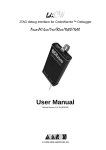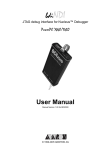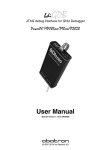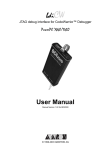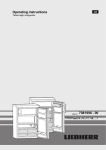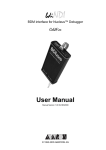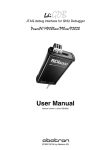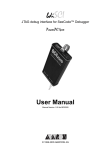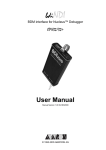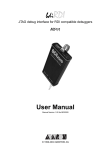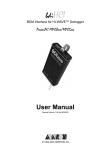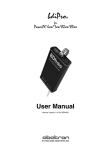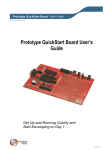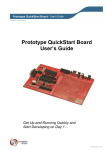Download bdiNDI_UserManual_MPC85xx
Transcript
bdiNDI
JTAG debug interface for Nucleus™ Debugger
PowerPC MPC85xx
User Manual
Manual Version 1.01 for BDI2000
© 1992-2007 ABATRON AG
bdiNDI
JTAG debug interface for Nucleus™ Debugger, BDI2000 (MPC85xx)
User Manual 2
1 Introduction ................................................................................................................................. 3
1.1 BDI2000................................................................................................................................. 3
2 Installation ................................................................................................................................... 4
2.1 Connecting the BDI2000 to Target......................................................................................... 4
2.1.1 Changing Target Processor Type ................................................................................. 6
2.2 Connecting the BDI2000 to Power Supply............................................................................. 7
2.3 Status LED «MODE»............................................................................................................. 8
2.4 Connecting the BDI2000 to the Host ..................................................................................... 9
2.4.1 Serial line communication ............................................................................................ 9
2.4.2 Ethernet communication ............................................................................................ 10
2.5 Installation of the Configuration Software ............................................................................ 11
2.6 Configuration ....................................................................................................................... 12
2.6.1 BDI2000 Setup/Update .............................................................................................. 12
3 Init List........................................................................................................................................ 14
4 BDI working modes................................................................................................................... 16
4.1 Startup Mode ....................................................................................................................... 17
5 Working with Nucleus ............................................................................................................... 18
5.1 Direct Commands ................................................................................................................ 18
5.1.1 Flash.Setup ................................................................................................................ 19
5.1.2 Flash.Erase ................................................................................................................ 19
5.1.3 Flash.Load ................................................................................................................. 19
5.1.4 Flash.Idle.................................................................................................................... 19
5.2 Download to Flash Memory................................................................................................. 20
6 Telnet Interface .......................................................................................................................... 23
7 Specifications ............................................................................................................................ 24
8 Environmental notice ................................................................................................................ 25
9 Declaration of Conformity (CE) ................................................................................................ 25
10 Warranty ................................................................................................................................... 26
Appendices
A Troubleshooting ........................................................................................................................ 27
B Maintenance .............................................................................................................................. 28
C Trademarks ................................................................................................................................ 30
© Copyright 1992-2007 by ABATRON AG
V 1.01
bdiNDI
JTAG debug interface for Nucleus™ Debugger, BDI2000 (MPC85xx)
User Manual 3
1 Introduction
Target System
Target System
MPC
85xx
MPC
85xx
JTAG Interface
BDI2000
JTAG Interface
BDI2000
PC Host
Nucleus
Abatron AG
Abatron AG
Swiss Made
RS232
Swiss Made
Ethernet (10 BASE-T)
The BDI2000 adds JTAG based debug features to the Nucleus debugger environment from Mentor
Graphic’s. With the BDI2000, you control and monitor the microcontroller solely through the stable
on-chip debugging services. You won’t waste time and target resources with a software ROM monitor,
and you eliminate the cabling problems typical of ICE’s. This combination runs even when the target
system crashes and allows developers to continue investigating the cause of the crash.
A RS232 interface with a maximum of 115 kBaud and a 10Base-T Ethernet interface is available for
the host interface.
The configuration software is used to update the firmware and to configure the BDI2000 so it works
with the Nucleus debugger.
1.1 BDI2000
The BDI2000 is a processor system in a small box. It implements the interface between the JTAG
pins of the target CPU and a 10Base-T Ethernet / RS232 connector. The firmware and the programmable logic of the BDI2000 can be updated by the user with a simple Windows based configuration
program. The BDI2000 supports 1.8 – 5.0 Volts target systems (3.0 – 5.0 Volts target systems with
Rev. B).
© Copyright 1992-2007 by ABATRON AG
V 1.01
bdiNDI
JTAG debug interface for Nucleus™ Debugger, BDI2000 (MPC85xx)
User Manual 4
2 Installation
2.1 Connecting the BDI2000 to Target
The cable to the target system is a 16 pin flat ribbon cable. In case where the target system has an
appropriate connector, the cable can be directly connected. The pin assignment is in accordance with
the PowerPC COP connector specification.
!
In order to ensure reliable operation of the BDI (EMC, runtimes, etc.) the target cable length must not
exceed 20 cm (8").
Target System
1
MPC
85xx
15
COP/JTAG Connector
16
2
BDI2000
BDI
Abatron AG
TRGT MODE
TARGET A
TARGET B
15
1
16
2
Swiss Made
The green LED «TRGT» marked light up when target is powered up
1 - TDO
2 - NC (QACK)
3 - TDI
4 - TRST
5 - NC (QREQ)
6 - Vcc Target
7 - TCK
8 - CHKSTP_IN
9 - TMS
10 - NC
11 - SRESET
12 - GROUND
13 - HRESET
14 - NC (key)
15 - CHKSTP_OUT
16 - GROUND
For BDI TARGET B connector signals see table on next page.
© Copyright 1992-2007 by ABATRON AG
V 1.01
bdiNDI
JTAG debug interface for Nucleus™ Debugger, BDI2000 (MPC85xx)
User Manual 5
BDI TARGET B Connector Signals:
Pin
Name
Describtion
1
TDO
JTAG Test Data Out
This input to the BDI2000 connects to the target TDO pin.
2
IO2
General purpose I/O
Currently not used.
3
TDI
JTAG Test Data In
This output of the BDI2000 connects to the target TDI pin.
4
TRST
JTAG Test Reset
This output of the BDI2000 resets the JTAG TAP controller on the target.
5
IN0
General purpose Input
Currently not used.
6
Vcc Target
1.8 – 5.0V:
This is the target reference voltage. It indicates that the target has power and it is also used
to create the logic-level reference for the input comparators. It also controls the output logic
levels to the target. It is normally connected to Vdd I/O on the target board.
3.0 – 5.0V with Rev. B :
This input to the BDI2000 is used to detect if the target is powered up. If there is a current
limiting resistor between this pin and the target Vdd, it should be 100 Ohm or less.
7
TCK
JTAG Test Clock
This output of the BDI2000 connects to the target TCK pin.
8
IO8
General purpose I/O
This output of the BDI2000 connects to the target CKSTP_IN pin. Currently not used.
9
TMS
JTAG Test Mode Select
This output of the BDI2000 connects to the target TMS line.
10
IO10
General purpose I/O
Currently not used.
11
SRESET
Soft-Reset
This open collector output of the BDI2000 connects to the target SRESET pin.
12
GROUND
System Ground
13
HRESET
Hard-Reset
This open collector output of the BDI2000 connects to the target HRESET pin.
14
<reseved>
15
IN1
General purpose Input
This input to the BDI2000 connects to the target CKSTP_OUT pin. Currently not used.
16
GROUND
System Ground
© Copyright 1992-2007 by ABATRON AG
V 1.01
bdiNDI
JTAG debug interface for Nucleus™ Debugger, BDI2000 (MPC85xx)
User Manual 6
2.1.1 Changing Target Processor Type
Before you can use the BDI2000 with an other target processor type (e.g. CPU32 <--> PPC), a new
setup has to be done (see Appendix A). During this process the target cable must be disconnected
from the target system. The BDI2000 needs to be supplied with 5 Volts via the BDI OPTION connector (Version A) or via the POWER connector (Version B). For more information see chapter 2.2.1
«External Power Supply».
!
To avoid data line conflicts, the BDI2000 must be disconnected from the target system while
programming the logic for an other target CPU.
© Copyright 1992-2007 by ABATRON AG
V 1.01
bdiNDI
JTAG debug interface for Nucleus™ Debugger, BDI2000 (MPC85xx)
User Manual 7
2.2 Connecting the BDI2000 to Power Supply
The BDI2000 needs to be supplied with 5 Volts (max. 1A) via the POWER connector. The available
power supply from Abatron (option) or the enclosed power cable can be directly connected. In order
to ensure reliable operation of the BDI2000, keep the power supply cable as short as possible.
!
For error-free operation, the power supply to the BDI2000 must be between 4.75V and 5.25V DC.
The maximal tolerable supply voltage is 5.25 VDC. Any higher voltage or a wrong polarity
might destroy the electronics.
Rev. B Version
GND 3
1 Vcc
2
4
RS232
BDI
TRGT MODE
POWER
Connector
POWER
TARGET A
LI
TX RX
10 BASE-T
1 - Vcc (+5V)
2 - VccTGT
3 - GROUND
4 - NOT USED
TARGET B
The green LED «BDI» marked light up when 5V power is connected to the BDI2000
Please switch on the system in the following sequence:
• 1 --> external power supply
• 2 --> target system
© Copyright 1992-2007 by ABATRON AG
V 1.01
bdiNDI
JTAG debug interface for Nucleus™ Debugger, BDI2000 (MPC85xx)
User Manual 8
2.3 Status LED «MODE»
The built in LED indicates the following BDI states:
BDI
TRGT MODE
MODE LED
TARGET A
TARGET B
BDI STATES
OFF
The BDI is ready for use, the firmware is already loaded.
ON
The power supply for the BDI2000 is < 4.75VDC.
BLINK
The BDI «loader mode» is active (an invalid firmware is loaded or loading firmware is active).
© Copyright 1992-2007 by ABATRON AG
V 1.01
bdiNDI
JTAG debug interface for Nucleus™ Debugger, BDI2000 (MPC85xx)
User Manual 9
2.4 Connecting the BDI2000 to the Host
2.4.1 Serial line communication
The host is connected to the BDI through the serial interface (COM1...COM4). The communication
cable between BDI and Host is a serial cable (RXD / TXD are crossed). There is the same connector
pinout for the BDI and for the Host side (Refer to Figure below).
Target System
RS232 Connector
(for PC host)
12345
MPC
85xx
1 - NC
2 - RXD data from host
3 - TXD data to host
4 - NC
5 - GROUND
6 - NC
7 - NC
8 - NC
9 - NC
6789
RS232
POWER
LI
TX RX
10 BASE-T
BDI2000
PC Host
Abatron AG
Swiss Made
RS232
© Copyright 1992-2007 by ABATRON AG
V 1.01
bdiNDI
User Manual 10
JTAG debug interface for Nucleus™ Debugger, BDI2000 (MPC85xx)
2.4.2 Ethernet communication
The BDI2000 has a built-in 10 BASE-T Ethernet interface (see figure below). Connect an UTP (Unshilded Twisted Pair) cable to the BD2000. For thin Ethernet coaxial networks you can connect a
commercially available media converter (BNC-->10 BASE-T) between your network and the
BDI2000. Contact your network administrator if you have questions about the network.
Target System
10 BASE-T
Connector
1 - TD+
2 - TD3 - RD+
4 - NC
5 - NC
6 - RD7 - NC
8 - NC
1
RS232
POWER
LI
TX RX
8
PPC
10 BASE-T
BDI2000
PC Host
Abatron AG
Swiss Made
Ethernet (10 BASE-T)
The following explains the meanings of the built-in LED lights:
LED
Name
Description
LI
Link
When this LED light is ON, data link is successful between the UTP
port of the BDI2000 and the hub to which it is connected.
TX
Transmit
When this LED light BLINKS, data is being transmitted through the UTP
port of the BDI2000
RX
Receive
When this LED light BLINKS, data is being received through the UTP
port of the BDI2000
© Copyright 1992-2007 by ABATRON AG
V 1.01
bdiNDI
JTAG debug interface for Nucleus™ Debugger, BDI2000 (MPC85xx)
User Manual 11
2.5 Installation of the Configuration Software
On the enclosed diskette you will find the BDI configuration software and the firmware required for
the BDI. Copy all these files to a directory on your hard disk.
The following files are on the diskette:
b20pq3.exe
Configuration program
b20pq3.hlp
Helpfile for the configuration program
b20pq3.cnt
Help contents file
b20pq3fw.xxx
Firmware for BDI2000 for COP targets (MPC85xx)
copjed20.xxx
JEDEC file for the BDI2000 (Rev. B) logic device programming
copjed21.xxx
JEDEC file for the BDI2000 (Rev. C) logic device programming
bdiifc32.dll
BDI Interface DLL for the configuration program
*.bdi
Configuration Examples
Example of an installation process:
• Copy the entire contents of the enclosed diskette into a directory on the hard disk.
• You may create a new shortcut to the b20pq3.exe configuration program.
© Copyright 1992-2007 by ABATRON AG
V 1.01
bdiNDI
JTAG debug interface for Nucleus™ Debugger, BDI2000 (MPC85xx)
User Manual 12
2.6 Configuration
Before you can use the BDI together with the debugger, the BDI must be configured. Use the SETUP
menu and follow the steps listed below:
• Load or update the firmware / logic, store IP address
--> Firmware
• Set the communication parameters between Host and BDI
--> Communication
• Setup an initialization list for the target processor
--> Initlist
• Select the working mode
--> Mode
• Transmit the configuration to the BDI
--> Mode Transmit
For information about the dialogs and menus use the help system (F1).
2.6.1 BDI2000 Setup/Update
First make sure that the BDI is properly connected (see Chapter 2.1 to 2.4). The BDI must be connected via RS232 to the Windows host.
!
To avoid data line conflicts, the BDI2000 must be disconnected from the target system while
programming the logic for an other target CPU (see Chapter 2.1.1).
The following dialogbox is used to check or update the BDI firmware and logic and to set the network
parameters.
dialog box «BDI2000 Update/Setup»
The following options allow you to check or update the BDI firmware and logic and to set the network
parameters:
Channel
Select the communication port where the BDI2000 is connected during
this setup session.
Baudrate
Select the baudrate used to communicate with the BDI2000 loader during
this setup session.
© Copyright 1992-2007 by ABATRON AG
V 1.01
bdiNDI
JTAG debug interface for Nucleus™ Debugger, BDI2000 (MPC85xx)
User Manual 13
Connect
Click on this button to establish a connection with the BDI2000 loader.
Once connected, the BDI2000 remains in loader mode until it is restarted
or this dialog box is closed.
Current
Press this button to read back the current loaded BDI2000 software and
logic versions. The current loader, firmware and logic version will be displayed.
Update
This button is only active if there is a newer firmware or logic version
present in the execution directory of the BDI setup software. Press this
button to write the new firmware and/or logic into the BDI2000 flash memory / programmable logic.
IP Address
Enter the IP address for the BDI2000.
Use the following format: xxx.xxx.xxx.xxxe.g.151.120.25.101
Ask your network administrator for assigning an IP address to this
BDI2000. Every BDI2000 in your network needs a different IP address.
Subnet Mask
Enter the subnet mask of the network where the BDI is connected to.
Use the following format: xxx.xxx.xxx.xxxe.g.255.255.255.0
A subnet mask of 255.255.255.255 disables the gateway feature.
Ask your network administrator for the correct subnet mask.
Default Gateway
Enter the IP address of the default gateway. Ask your network administrator for the correct gateway IP address. If the gateway feature is disabled,
you may enter 255.255.255.255 or any other value..
Transmit
Click on this button to store the network configuration in the BDI2000 flash
memory.
In rare instances you may not be able to load the firmware in spite of a correctly connected BDI (error
of the previous firmware in the flash memory). Before carrying out the following procedure, check
the possibilities in Appendix «Troubleshooting». In case you do not have any success with the
tips there, do the following:
• Switch OFF the power supply for the BDI and open the unit as
described in Appendix «Maintenance»
• Place the jumper in the «INIT MODE» position
• Connect the power cable or target cable if the BDI is powered
from target system
• Switch ON the power supply for the BDI again and wait until the
LED «MODE» blinks fast
INIT MODE
• Turn the power supply OFF again
DEFAULT
• Return the jumper to the «DEFAULT» position
• Reassemble the unit as described in Appendix «Maintenance»
© Copyright 1992-2007 by ABATRON AG
V 1.01
bdiNDI
JTAG debug interface for Nucleus™ Debugger, BDI2000 (MPC85xx)
User Manual 14
3 Init List
dialog box «Startup Init List»
In order to prepare the target for debugging, you can define an Initialization List. This list is stored in
the Flash memory of the BDI2000 and worked through every time the target comes out of reset. Use
it to get the target operational after a reset. The memory system is usually initialized through this list.
After processing the init list, the RAM used to download the application must be accessible.
Use on-line help (F1) and the supplied configuration examples on the distribution disk to get more
information about the init list.
© Copyright 1992-2007 by ABATRON AG
V 1.01
bdiNDI
JTAG debug interface for Nucleus™ Debugger, BDI2000 (MPC85xx)
User Manual 15
Special BDI Configuration Registers:
In order to change some special configuration parameters of the BDI, the SPR entry in the init list is
used. Normal PPC SPR's covers a range from 0 to 1023. Other SPR's are used to set BDI internal
registers:
8001
Write to this special register with a value of 1, if the BDI should use the alternate single step
mode. The alternate mode does not use the JTAG single step feature to implement single
stepping. It uses always a hardware breakpoint (via IABR) on the next instruction to implement single stepping.
8002
This entry in the init list allows to define a delay time (in ms) the BDI inserts between releasing the COP-HRESET line and starting communicating with the target. This init list entry may
be necessary if COP-HRESET is delayed on its way to the PowerPC reset pin.
8003
<reserved>
8004
This parameter defines how the BDI accesses memory via JTAG. By default it uses the System Access Port (SAP). Alternatively the BDI can use the e500 core to access memory. Enter a value of 0 if the BDI should use the e500 core to access memory. A value of 1 (default)
uses the System Access Port (SAP) to access memory.
8005
By default, the BDI asserts the HRESET signal during reset processing. After writing zero
to this special register, the BDI no longer drives HRESET low. This may be useful in some
special cases.
8006
This entry in the init list allows to define a time (in ms) the BDI asserts the hardware reset
signal. By default the reset signal (HRESET) is asserted for about 300 ms.
The BDI can also handle systems with multiple devices connected to the JTAG scan chain. In order
to put the other devices into BYPASS mode and to count for the additional bypass registers, the BDI
needs some information about the scan chain layout. Enter the number and total instruction register
(IR) length of the devices present before the PowerPC chip. Enter the appropriate information also
for the devices following the PowerPC chip.
8011
Number of JTAG devices connected before the PowerPC chip.
8012
Total IR length of the JTAG devices connected before the PowerPC chip
8013
Number of JTAG devices connected after the PowerPC chip
8014
Total IR length of the JTAG devices connected after the PowerPC chip
© Copyright 1992-2007 by ABATRON AG
V 1.01
bdiNDI
JTAG debug interface for Nucleus™ Debugger, BDI2000 (MPC85xx)
User Manual 16
4 BDI working modes
dialog box «BDI Working Mode»
With this dialog box you can define how the BDI interacts with the target system.
Identification
Enter a text to identify this setup.
Startup
Startup mode defines how the BDI interacts with the target processor after
reset or power up. The options LOOP, HALT, STOP or RUN can be selected.
CPU Type
Select the CPU type of the target system.
JTAG Clock
This option allows to select the used JTAG clock rate.
Run Time
When startup mode STOP is selected, this option allows to set the run
time after reset in milliseconds until the target CPU is stopped. Values
from 100 (0.1 sec) till 32000 (32 sec) are accepted.
Transmit
Click on this button to send the initialization list and the working mode to
the BDI. This is normally the last step done before the BDI can be used
with the debugging system.
© Copyright 1992-2007 by ABATRON AG
V 1.01
bdiNDI
JTAG debug interface for Nucleus™ Debugger, BDI2000 (MPC85xx)
User Manual 17
4.1 Startup Mode
Startup mode defines how the BDI interacts with the target system after a reset or a power up sequence.
LOOP
This default mode forces the target to debug mode immediately out of reset. For
this, L2SRAM is mapped to the initial boot page with an endless loop at 0xfffffffc.
HALT
Also this mode forces the target to debug mode immediately out of reset but without
mapping L2SRAM. This works only if the processor can fetch a valid opcode from
the boot address at 0xfffffffc.
STOP
In this mode, the BDI lets the target execute code for "runtime" milliseconds after
reset. This mode is useful when monitor code should initialize the target system.
RUN
After reset, the target executes code until stopped by the debugger or the Telnet
"halt" command.
Target Reset Sequence (STARTUP LOOP mode):
In order to get control of the core immediately out of reset, the BDI uses a special startup sequence
where L2SRAM is mapped to the initial boot page and an endless loop is written to 0xfffffffc. This is
done while the core is still kept in reset state. Then the core is released and starts executing this loop
at 0xfffffffc until the BDI halts it via the appropriate JTAG command. Therefore after a reset sequence
L2SRAM is mapped to 0xfffc0000...0xffffffff. To disable this mapping, enter the appropriate init list entry that disables L2SRAM.
WM32
0xFF720000
0x20000000
;L2CTL : disable L2SRAM
Debug Interrupt (IVOR15):
Debugging via JTAG and flash programming with workspace works only if the Debug Interrupt Vector
contains a valid instruction that can be fetched by the e500 core. This because the e500 core does
first interrupt processing before it halts. If IVPR + IVOR15 do not point to a valid and fetchable (MMU)
instruction the e500 will crash. If necessary (for example for flash programming) setup a valid Debug
Interrupt Vector via some init list entries:
; Setup flash programming workspace in L2SRAM
WM32
0x40020000
0x68010000
;L2CTL
WM32
0x40020100
0xf0000000
;L2SRBAR0
WM32
0x40020000
0xA8010000
;L2CTL
WSPR
63
0xf0000000
;IVPR to workspace
WSPR
415
0x00001500
;IVOR15 : Debug exception
WM32
0xf0001500
0x48000000
;write valid instruction
Because a Debug Interrupt writes to CSRR0 and CSRR1, it is not possible to debug the entry/exit
code of a critical interrupt handler.
© Copyright 1992-2007 by ABATRON AG
V 1.01
bdiNDI
JTAG debug interface for Nucleus™ Debugger, BDI2000 (MPC85xx)
User Manual 18
5 Working with Nucleus
For information about using the Nucleus debugger look at the appropriate Nucleus user’s manual.
5.1 Direct Commands
For special functions (mainly for flash programming) the BDI supports so called «Direct Commands».
This commands can be entered in a codelet file (e.g. PRELOAD.CDL) or directly executed in the Nucleus Debugger Command Line Window. This Direct Commands are not interpreted by the Nucleus
Debugger but directly sent to the BDI. After processing the command the result is displayed in the
Nucleus Debugger Command Line Window.
Direct Commands are ASCII - Strings with the following structure:
<Object>.<Action> [<ParName>=<ParValue>]...
Example:
flash.erase addr=0x02800000
All names are case insensitive. Parameter values are numbers or strings. Numeric parameters can
be entered as decimal (e.g. 700) or as hexadecimal (0x80000) values.
If the commands are directly entered in the Nucleus Debugger Command Line Window, use the following syntax:
bdi "direct-command"
Example:
bdi "flash.erase addr=0x02800000"
© Copyright 1992-2007 by ABATRON AG
V 1.01
bdiNDI
JTAG debug interface for Nucleus™ Debugger, BDI2000 (MPC85xx)
User Manual 19
5.1.1 Flash.Setup
In order to support loading into flash memory, the BDI needs some information about the used flash
devices. Before any other flash related command can be used, this direct command must be executed.
Syntax:
flash.setup type=am29f size=0x80000 bus=32 workspace=0x1000
type
This parameter defines the type of flash used. It is used to select the correct programming algorithm. The following flash types are supported:
AM29F, AM29BX8, AM29BX16, I28BX8, I28BX16, AT49, AT49X8, AT49X16,
STRATAX8, STRATAX16, MIRROR, MORRORX8, MIRRORX16,
I28BX32, AM29DX16, AM29DX32
The size of one flash chip in bytes (e.g. AM29F010 = 0x20000). This value is used to
calculate the starting address of the current flash memory bank.
The width of the memory bus that leads to the flash chips. Do not enter the width of
the flash chip itself. The parameter TYPE carries the information about the number of
data lines connected to one flash chip. For example, enter 16 if you are using two
AM29F010 to build a 16bit flash memory bank.
If a workspace is defined, the BDI uses a faster programming algorithm that run out of
RAM on the target system. Otherwise, the algorithm is processed within the BDI. The
workspace is used for a 1kByte data buffer and to store the algorithm code. There must
be at least 2kBytes of RAM available for this purpose.
size
bus
workspace
5.1.2 Flash.Erase
This command allows to erase one flash sector, block or chip.
Syntax:
flash.erase addr=0x02800000 mode=chip
addr
mode
The start address of the flash sector to erase.
This parameter defines the erase mode. The following modes are supported:
CHIP, BLOCK and SECTOR (default is sector erase)
5.1.3 Flash.Load
This command enables loading to flash memory. If the address of a data block is within the given
flash range, the BDI automatically uses the appropriate programming algorithm. This command must
be executed before downloading is started.
Syntax:
flash.load addr=0x02800000 size=0x200000
addr
size
The start address of the flash memory
The size of the flash memory
5.1.4 Flash.Idle
This command disables loading to flash memory.
Syntax:
flash.idle
© Copyright 1992-2007 by ABATRON AG
V 1.01
bdiNDI
JTAG debug interface for Nucleus™ Debugger, BDI2000 (MPC85xx)
User Manual 20
5.2 Download to Flash Memory
The BDI supports programming flash memory. To automate the process of downloading to flash
memory a codelet can be used. Following an example of such a codelet:
void flash_load(int coreId)
{
char output[256];
printf("Specifying the flash type...");
command("bdi flash.setup type=AM29F size=0x00800000 bus=8",output, 256);
printf("%s\n", output);
printf("Erasing the first sector...");
command("bdi flash.erase addr=0xfff00000 mode=sector", output,256);
printf("%s\n", output);
printf("Erasing the second sector...");
command("bdi flash.erase addr=0xfff10000 mode=sector", output,256);
printf("%s\n", output);
printf("Erasing the third sector...");
command("bdi flash.erase addr=0xfff20000 mode=sector", output,256);
printf("%s\n", output);
printf("Setting load address...");
command("bdi flash.load addr=0xfff00000 size=0x00020000",output, 256);
printf("%s\n", output);
printf("Loading the image...");
command("load C:\\MGC\\embedded\\Nucleus\\demo\\out\\plus_demo.out", output, 256);
printf("%s\n", output);
printf("Taking the BDI out of Flashing mode...");
command("bdi flash.idle", output, 256);
printf("%s\n", output);
}
A user who needs to reflash often can just call such a codelet from the Nucleus Debugger command
view by typing flash_load(1) at the command prompt. For this to work two steps are required:
1. The codelet file must first be loaded into EGDE.
• From the Run Menu select "Codelet Composer"
• On the Codelet Composer dialog click the Load button.
• Browse to and select your *.cdl file.
• To complete the operation click the Open button.
Alternatively, any *.cdl file that is simply imported into one of the user's projects will be identified by
Nucleus Debugger.
2. Since the flashing commands are issued over the debug connection, this of course requires that
a connection to already been established to the target.
In addition, the contents of the codelet can be placed in the user's initialization codelet and thus be
called automatically after connect.
© Copyright 1992-2007 by ABATRON AG
V 1.01
bdiNDI
User Manual 21
JTAG debug interface for Nucleus™ Debugger, BDI2000 (MPC85xx)
Supported Flash Memories:
There are currently 3 standard flash algorithm supported. The AMD, Intel and Atmel AT49 algorithm.
Almost all currently available flash memories can be programmed with one of this algorithm. The
flash type selects the appropriate algorithm and gives additional information about the used flash.
For 8bit only flash:
AM29F (MIRROR), I28BX8, AT49
For 8/16 bit flash in 8bit mode:
AM29BX8 (MIRRORX8), I28BX8 (STRATAX8), AT49X8
For 8/16 bit flash in 16bit mode:
AM29BX16 (MIRRORX16), I28BX16 (STRATAX16), AT49X16
For 16bit only flash:
AM29BX16, I28BX16, AT49X16
For 16/32 bit flash in 16bit mode: AM29DX16
For 16/32 bit flash in 32bit mode: AM29DX32
For 32bit only flash:
I28BX32
The AMD and AT49 algorithm are almost the same. The only difference is, that the AT49 algorithm
does not check for the AMD status bit 5 (Exceeded Timing Limits).
Only the AMD and AT49 algorithm support chip erase. Block erase is only supported with the AT49
algorithm. If the algorithm does not support the selected mode, sector erase is performed. If the chip
does not support the selected mode, erasing will fail. The erase command sequence is different only
in the 6th write cycle. Depending on the selected mode, the following data is written in this cycle (see
also flash data sheets): 0x10 for chip erase, 0x30 for sector erase, 0x50 for block erase.
To speed up programming of Intel Strata Flash and AMD MirrorBit Flash, an additional algorithm is
implemented that makes use of the write buffer. This algorithm needs a workspace, otherwise the
standard Intel/AMD algorithm is used.
The following table shows some examples:
Flash
x8
x 16
x 32
Chipsize
AM29F
-
-
0x020000
Am29F800B
AM29BX8
AM29BX16
-
0x100000
Am29DL323C
AM29BX8
AM29BX16
-
0x400000
Am29PDL128G
-
AM29DX16
AM29DX32
0x01000000
Intel 28F032B3
I28BX8
-
-
0x400000
Intel 28F640J3A
STRATAX8
STRATAX16
-
0x800000
Intel 28F320C3
-
I28BX16
-
0x400000
AT49BV040
AT49
-
-
0x080000
AT49BV1614
AT49X8
AT49X16
-
0x200000
M58BW016BT
-
-
I28BX32
0x200000
SST39VF160
-
AT49X16
-
0x200000
Am29LV320M
MIRRORX8
MIRRORX16
-
0x400000
Am29F010
© Copyright 1992-2007 by ABATRON AG
V 1.01
bdiNDI
JTAG debug interface for Nucleus™ Debugger, BDI2000 (MPC85xx)
User Manual 22
Note:
Some Intel flash chips (e.g. 28F800C3, 28F160C3, 28F320C3) power-up with all blocks in locked
state. In order to erase/program those flash chips, use the init list to unlock the appropriate blocks.
WM16
WM16
WM16
WM16
WM16
0xFFF00000
0xFFF00000
0xFFF10000
0xFFF10000
....
0xFFF00000
0x0060
0x00D0
0x0060
0x00D0
unlock block 0
0xFFFF
select read mode
unlock block 1
Not all flash chips support a chip erase command. Also if a chip erase takes too long, the BDI communication layer may time-out. In this case, use multiple sector erase commands
© Copyright 1992-2007 by ABATRON AG
V 1.01
bdiNDI
JTAG debug interface for Nucleus™ Debugger, BDI2000 (MPC85xx)
User Manual 23
6 Telnet Interface
A Telnet server is integrated within the BDI that can be accessed when the BDI is connected via ethernet to the host. It may help to invertigate problems and allows access to target resources that can
not directly be accessed by the debugger.
The following commands are available:
"MD
[<address>] [<count>]
"MDD
[<address>] [<count>]
"MDH
[<address>] [<count>]
"MDB
[<address>] [<count>]
"MM
<addr> <value> [<cnt>]
"MMD
<addr> <value> [<cnt>]
"MMH
<addr> <value> [<cnt>]
"MMB
<addr> <value> [<cnt>]
"MC
[<address>] [<count>]
"MV
"RD
"RDSPR <number>
"RDPMR <number>
"RM
<number> <value>
"RMSPR <number> <value>
"RMPMR <number>
<value>
"DCACHE <addr | set>
"ICACHE <addr | set>
"L2CACHE <set>
"L2SRAM <addr>
"L2TLB <from> [<to>]
"L2CAM <from> [<to>]
"UPMR <MxMR> <MDR> <addr>
"RESET
"GO
[<pc>]
"TI
[<pc>]
"TC
[<pc>]
"HALT
"BI <addr>
"CI [<id>]
"BD [R|W] <addr>
"CD [<id>]
"INFO
"DCMD <direct command>
"HELP
"SAP
[0 | 1]
"BOOT
"QUIT
display target memory as word (32bit)",
display target memory as double word (64bit)",
display target memory as half word (16bit)",
display target memory as byte (8bit)",
modify word(s) (32bit) in target memory",
modify double word(s) (64bit) in target memory",
modify half word(s) (16bit) in target memory",
modify byte(s) (8bit) in target memory",
calculates a checksum over a memory range",
verifies the last calculated checksum",
display general purpose registers",
display special purpose register",
display performance monitor register",
modify general purpose or user defined register",
modify special purpose register",
modify performance monitor register",
display L1 data cache content",
display L1 inst cache content",
display L2 cache content",
display L2 SRAM content",
display L2 TLB0 entry",
display L2 TLB1 entry",
read selected UPM array",
reset the target system",
set PC and start target system",
trace on instuction (single step)",
trace on change of flow",
force target to enter debug mode",
set instruction hardware breakpoint",
clear instruction hardware breakpoint(s)",
set data watchpoint",
clear data watchpoint(s)",
display information about the current state",
execute a BDI direct command (see manual)",
display command list",
enable / disable JTAG memory access via SAP",
reset the BDI and reload the configuration",
terminate the Telnet session"
How to enter 64bit values:
The syntax for 64 bit parameters is : <high word>_<low word>
The "high word" and "low word" can be entered as decimal or hexadecimal. They are handled as two
separate values concatenated with an underscore.
0x01234567_0x89abcdef
1_0
256
3_0x1234
0x80000000_0
=>>
=>>
=>>
=>>
=>>
0x0123456789abcdef
0x0000000100000000
0x0000000000000100
0x0000000300001234
0x8000000000000000
© Copyright 1992-2007 by ABATRON AG
V 1.01
bdiNDI
JTAG debug interface for Nucleus™ Debugger, BDI2000 (MPC85xx)
User Manual 24
7 Specifications
Operating Voltage Limiting
5 VDC ± 0.25 V
Power Supply Current
typ. 500 mA
max. 1000 mA
RS232 Interface: Baud Rates
Data Bits
Parity Bits
Stop Bits
9’600,19’200, 38’400, 57’600,115’200
8
none
1
Network Interface
10 BASE-T
Serial Transfer Rate between BDI and Target
up to 16 Mbit/s
Supported target voltage
1.8 – 5.0 V (3.0 – 5.0 V with Rev. B)
Operating Temperature
+ 5 °C ... +60 °C
Storage Temperature
-20 °C ... +65 °C
Relative Humidity (noncondensing)
<90 %rF
Size
190 x 110 x 35 mm
Weight (without cables)
420 g
Host Cable length (RS232)
2.5 m
Specifications subject to change without notice
© Copyright 1992-2007 by ABATRON AG
V 1.01
bdiNDI
JTAG debug interface for Nucleus™ Debugger, BDI2000 (MPC85xx)
User Manual 25
8 Environmental notice
Disposal of the equipment must be carried out at a designated disposal site.
9 Declaration of Conformity (CE)
© Copyright 1992-2007 by ABATRON AG
V 1.01
bdiNDI
JTAG debug interface for Nucleus™ Debugger, BDI2000 (MPC85xx)
User Manual 26
10 Warranty
ABATRON Switzerland warrants the physical diskette, cable, BDI2000 and physical documentation
to be free of defects in materials and workmanship for a period of 24 months following the date of
purchase when used under normal conditions.
In the event of notification within the warranty period of defects in material or workmanship,
ABATRON will replace defective diskette, cable, BDI2000 or documentation. The remedy for breach
of this warranty shall be limited to replacement and shall not encompass any other damages, including but not limited loss of profit, special, incidental, consequential, or other similar claims.
ABATRON Switzerland specifically disclaims all other warranties- expressed or implied, including but
not limited to implied warranties of merchantability and fitness for particular purposes - with respect
to defects in the diskette, cable, BDI2000 and documentation, and the program license granted herein, including without limitation the operation of the program with respect to any particular application,
use, or purposes. In no event shall ABATRON be liable for any loss of profit or any other commercial
damage, including but not limited to special, incidental, consequential, or other damages.
Failure in handling which leads to defects are not covered under this warranty. The warranty is void
under any self-made repair operation except exchanging the fuse.
© Copyright 1992-2007 by ABATRON AG
V 1.01
bdiNDI
JTAG debug interface for Nucleus™ Debugger, BDI2000 (MPC85xx)
User Manual 27
Appendices
A Troubleshooting
Problem
The firmware can not be loaded.
Possible reasons
• The BDI is not correctly connected with the target system (see chapter 2).
• The power supply of the target system is switched off or not in operating range
(4.75 VDC ... 5.25 VDC) --> MODE LED is OFF or RED
• The built in fuse is damaged --> MODE LED is OFF
• The BDI is not correctly connected with the Host (see chapter 2).
• A wrong communication port (Com 1...Com 4) is selected.
Problem
No working with the target system (loading firmware is ok).
Possible reasons
• Wrong pin assignment (BDM/JTAG connector) of the target system (see chapter 2).
• Target system initialization is not correctly --> enter an appropriate target initialization list.
• An incorrect IP address was entered (BDI2000 configuration)
• BDM/JTAG signals from the target system are not correctly (short-circuit, break, ...).
• The target system is damaged.
Problem
Network processes do not function (loading the firmware was successful)
Possible reasons
• The BDI2000 is not connected or not correctly connected to the network (LAN cable or media
converter)
• An incorrect IP address was entered (BDI2000 configuration)
© Copyright 1992-2007 by ABATRON AG
V 1.01
bdiNDI
JTAG debug interface for Nucleus™ Debugger, BDI2000 (MPC85xx)
User Manual 28
B Maintenance
The BDI needs no special maintenance. Clean the housing with a mild detergent only. Solvents such
as gasoline may damage it.
If the BDI is connected correctly and it is still not responding, then the built in fuse might be damaged
(in cases where the device was used with wrong supply voltage or wrong polarity). To exchange the
fuse or to perform special initialization, please proceed according to the following steps:
!
Observe precautions for handling (Electrostatic sensitive device)
Unplug the cables before opening the cover.
Use exact fuse replacement (Microfuse MSF 1.6 AF).
Swiss Made
1.1 Unplug the cables
2
2.1 Remove the two plastic caps that cover the screws on target front side
(e.g. with a small knife)
2.2 Remove the two screws that hold the front panel
BDI
3
Abatron AG
BDI2000
1
TRGT MODE
BDI MAIN
BDI OPTION
3.1 While holding the casing, remove the front panel and the red elastic sealing
casing
elastic sealing
front panel
© Copyright 1992-2007 by ABATRON AG
V 1.01
bdiNDI
4
JTAG debug interface for Nucleus™ Debugger, BDI2000 (MPC85xx)
User Manual 29
4.1 While holding the casing, slide carefully the print in position as shown in
figure below
Jumper settings
DEFAULT
INIT MODE
Fuse Position
Rev. B/C
Fuse Position
Rev. A
Pull-out carefully the fuse and replace it
Type: Microfuse MSF 1.6AF
Manufacturer: Schurter
5
Reinstallation
5.1 Slide back carefully the print. Check that the LEDs align with the holes in the
back panel.
5.2 Push carefully the front panel and the red elastig sealing on the casing.
Check that the LEDs align with the holes in the front panel and that the
position of the sealing is as shown in the figure below.
casing
elastic sealing
back panel
front panel
5.3 Mount the screws (do not overtighten it)
5.4 Mount the two plastic caps that cover the screws
5.5 Plug the cables
!
Observe precautions for handling (Electrostatic sensitive device)
Unplug the cables before opening the cover.
Use exact fuse replacement (Microfuse MSF 1.6 AF).
© Copyright 1992-2007 by ABATRON AG
V 1.01
bdiNDI
JTAG debug interface for Nucleus™ Debugger, BDI2000 (MPC85xx)
User Manual 30
C Trademarks
All trademarks are property of their respective holders.
© Copyright 1992-2007 by ABATRON AG
V 1.01






























